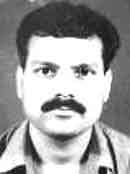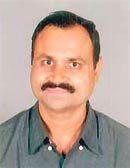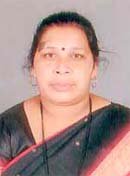Contents: 2024 | 2023 | 2022 | 2021 | 2020 | 2019 | 2018 | 2017 | 2016 | 2015 | 2014 | 2013 | 2012 | 2011 | 2010 | 2009 | 2008 | 2007 | 2006 | 2005 | 2004 | 2003 | 2002 | 2001
2005, 37
Simplified instrumentation for ultrasonic measurements
language: English
received 18.10.2005, published 04.12.2005
Download article (PDF, 160 kb, ZIP), use browser command "Save Target As..."
To read this document you need Adobe Acrobat © Reader software, which is simple to use and available at no cost. Use version 4.0 or higher. You can download software from Adobe site (http://www.adobe.com/).
ABSTRACT
Simplified instrumentation for ultrasonic measurements to generate and detect ultrasonic pulses in liquids and solids is described. High frequency pulse generator is assembled using integrated circuits (74LS00, 74LS90, 74LS93, 4093, 74121 and 7407), which generates variable frequencies (0.625, 1, 1.25, 2.5, 5 and 10 MHz), having pulse width 2 microseconds to 60 microseconds. The wideband receiver is developed using radio frequency amplifier (IC CA3028), zero-cross detector (LM393), and buffer amplifier (AD 826). The gain and bandwidth of the receiver are 50 dB and 15 MHz respectively. Transit time measurement has been taken on personal computer using analog to digital converter card. The system is found suitable, accurate and versatile for ultrasonic velocity and attenuation measurements.
8 pages, 7 figures
Сitation: Y. B. Gandole, S. P. Yawale, S. S. Yawale. Simplified instrumentation for ultrasonic measurements. Electronic Journal “Technical Acoustics”, http://www.ejta.org, 2005, 37.
REFERENCES
[1] Green R. E. Jr. NDE: Material Charactererisation and Reliability Strategies. Eds. O. Buck and S. M. Wolf, 115–132, 1981.
[2] Hull D. R., Kaultz H. E., A. Vary. Measurement of Ultrasonic velocity using Phase-slop and Cross-correlation Methods. Materials Evaluation, 43, 1455–1460, 1985.
[3] Jayakumar T., Baldev Raj, Willems H., Arnold W. Influence of microstructure on ultrasonic velocity in Nimonic Alloy PE-16. Proc. Review of Progress in QNDE. Edited by D. O. Thompson and Chimenti, Plenum Press, New York, 10, 1693–1700, 1990.
[4] Agnihotri P. K., Adgaonkar C. S. Theoretical evaluation of ultrasonic velocity in binary liquid mixtures. Research and Industry, 33, 139, 1988.
[5] Beyer R. T., Letcher S. V. Physical ultrasonic. Academic Press, New York, p. 87, 1969.
[6] Satyabala S. P., Rao M., Suryanarayana M. Sing-around technique of determining ultrasonic velocity in liquids using a single transducer. Acoust. lett., 2, 29, 1978.
[7] Soitkar V. S., Sunnapwar K. P., Navaneet G. N. Receiving Systems design for Sing-around Technique in Ultrasonic Measurements. Indian J. Tech., 18, 469, 1980.
[8] Papadakies P, New, compact instrument for pulse-echo-overlap measurements of ultrasonic wave transit times. Rev Sci. Instrum., 47, 806, 1976.
[9] Chung D. H., Silversmit D. J., Chick B. B. A Modified Ultrasonic Pulse-Echo-Overlap Method for Determining Sound Velocities and Attenuation of Solids. Rev. Sci. Instrum., 40, 718, 1969.
[10] Hellier A. G., Palmer S. B., Whitehead D. G. An integrated circuit pulse echo overlap facility for measurement of velocity of sound (applied to study of magnetic phase change). Journal of Physics E: Scientific Instrument. 8, 352-354, 1975.
[11] Aggarwal V. C., Gupta A. K. Acoustic attenuation and velocity measurements in a methanol and cyclohexane critical mixture. J. Phys. D: Appl. Phys., 8, 2232–2236, 1975.
[12] Suc-Kyoung Hong, Young Gie Ohr. Ultrasonic speckle pattern correlation interferometry using a pulse-echo method. J. Phys. D: Appl. Phys., 31, 1392–1396, 1998.
[13] Dignum R. Brief Review of Ultrasonic Attenuation with Some Emphasis on Work at Ultrahigh Frequency. Am. J. Phys., 32, 507, 1964.
[14] Canxia Kan, Weiping Cai, Cuncheng Li, Lide Zhang, H Hofmeister. Ultrasonic synthesis and optical properties of Au/Pd bimetallic nanoparticles in ethylene glycol. J. Phys. D: Appl. Phys., 36, 1609–1614, 2003.
[15] Dixon S., Edwards C., Palmer S. B., Reed J. Ultrasonic generation using a plasma igniter. J. Phys. D: Appl. Phys., 34, 1075–1082, 2001.
[16] Yawale S. P., Pakade S. V. Solid state variable frequency pulser-receiver system for ultrasonic measurements. Indian J. of pure & App. Phys., 33, 638–642, 1995.
[17] Millman J., Halkias C. Integrated electronics. Mc Hill Ltd, Tokyo, p. 560, 1972.
[18] A. A. Berdyev, B. Khemraev. Method of investigating the acoustical properties of liquids at frequencies of 300–1000 Mc, Russian J. Phys. Chem., 41, 1490, 1967.
[19] D. E. Gray. American Institute of Physics Handbook, 3rd ed., Mc Graw-Hill, New York, 1972.
[20] D. F. Evans, J. Thomas, J. A. Nadas, M. A. Matesich. Conductance of electrolytes in acetone and in 1-propanol-acetone mixtures at 25?deg. J. Phys. Chem., 75, 1714, 1971.
[21] Gorodetsky G., Lochterman I. Pulse-echo ultrasonic interferometer for the automatic measurements of velocity and attenuation changes. Rev. Sci., Instrum., 52, 1386, 1981.
[22] Malcolm Povey, Ultrasonic Techniques for Fluids Characterization, ISBN 0-12-563730-6, 214, 1997.
[23] Mukherjee S., Basu C., Ghosh U. S. Ultrasonic properties of V2O5P2O5 amorphous materials at different temperatures. J. Non-cryst. Solids, 144, 159, 1992.
[24] Pathak L, Murli N., Amritha V. P. Stand-alone pulse-echo-overlap facility for ultrasonic wave transit time measurements. Rev. Sci. Instrum., 55, 1817, 1984.
[25] Pathak L., Palanisami K. Achieving pulse-echo overlap with scopes having no intensity modulation. Rev. Sci., Instrum., 57, 123, 1986.
[26] San Emeterio J. L., Ramos A., Sanz P. T., Ruiz A., Azbaid A. Modeling NDT piezoelectric ultrasonic transmitters, Rev.: ULTRASONICS, vol. 42, pp. 277–281, 2004
[27] Timrot D. L., Serrendnitskaya M. A., Chkhikvadze T. D., Velocity of sound in liquid
sulfur near the lambda-transition point. Sov. Phys. Dokl. 29, 961, 1984.
[28] Vigoureux P. Ultrasonics, Chapman and hall, London, p. 112, 1952.
[29] W. Schaaff, Numerical data and functional relationalships in science and technology, New series group II: Atomic and molecular Physics, vol.5: Molecular Acoustics, Eds: K. H. Hellwege, A. M. Hellweg. Springer-verlag, Berlin, Heidelberg, New York, 1967.
[30] Weast, Robert C. ed. Handbook of Chemistry and Physics. 45th ed., Chemical Rubber Co., Cleveland Ohio, p. E-28. 1964.
 |
Yogendra Babarao Gandole received M.Sc. Applied Electronics degree from Amravati University, Amravati in 1987, Advance Diploma in Computer Software, System Analysis and Application from Bombay technical Board, Bombay in 1992, M.Sc. Subject communication (Electronics) from Yashawantrao Chavan Maharashtra Open University, Nashik in 2000. He is working as a lecturer in Adarsha science, J.B.Arts and Birla Commerce, Mahavidyalaya, Dhamangaon Rly since 1988. Presently he is working at Government Vidarbha Institute of Science and Humanities, Amravati, under Faculty Improvement Scheme (FIP) of University Grants Commission, New Delhi (India) for two years. e-mail: ygandole(at)indiatimes.com |
|
 |
Shrikrishna Pandurangji Yawale Shrikrishna Pandurangji Yawale received M.Sc. Physics degree from Amravati University, Amravati in 1986, M.Phil. in 1989 and Ph.D. in 1992 from the same University. He worked as a lecturer in the Government Vidarbha Institute of Science and Humanities, Amravati, since 1986 and now working as a reader and head of department of Electronics. Since 1986, he has been actively engaged in the research. In the mean time he had worked at Institute of Science, Nagpur. The current interests of research are solid state physics and materials science. The fields are glasses, amorphous materials, thin film polymers, solid state gas and humidity sensors, microwaves, ultrasonic instrumentation and dielectrics. Under his guidance five students have been awarded by Ph.D. degree from Amravati University, Amravati. Till now 56 research papers are published in national and international journals. He is life member of Indian Institute of Ceramics. Kolkata (India). E-mail: spyawale(at)rediffmail.com |
|
 |
Sangita Shrikrishna Yawale received M.Sc. degree in Physics in 1986, M.Phil in 1989 and Ph.D. in solid state Physics in 1992 from Amravati University, Amravati. She received M.Sc. Subject Communication (Physics) in 2005 from Yashawantrao Chavan Maharashtra Open University, Nashik. Since 1986 she is engaged in the research field of solid state Physics. She joined the Department of Physics, Government Vidarbha Institute of Science and Humanities, Amravati, in 1986 as a lecturer and now working as reader. Her research fields are glasses, dielectrics, ultrasonic, polymers etc. Under her guidance two students have been awarded Ph.D. degree. She has published 56 research papers in international journals and conferences. E-mail: ssyawale(at)rediffmail.com |
|
